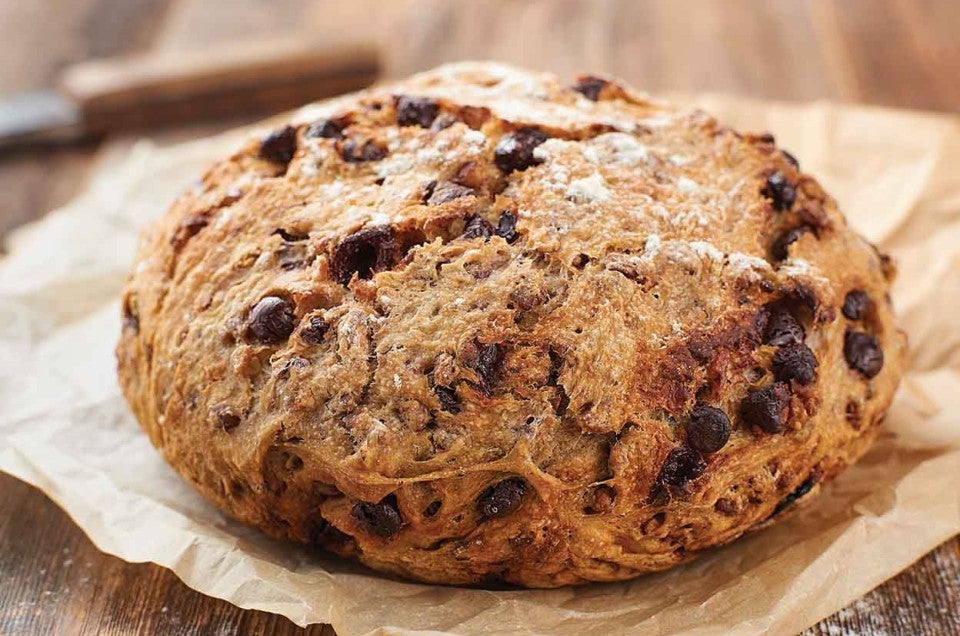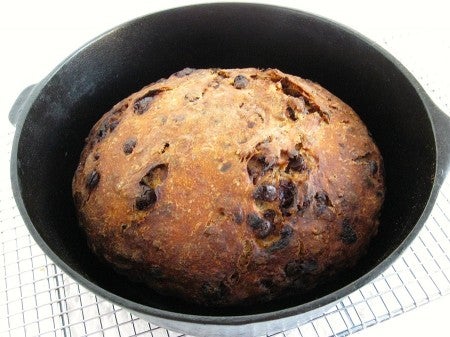


You know those really dense, chewy rounds of bread you can buy at artisan bread bakeries?
Breads with a satiny, dark-brown crust, packed with fruit and nuts and, most of all, with incredible flavor from their long, slow rise?
Believe it or not, you – yes, YOU – can make a loaf like this at home. With no particular talent, and no special equipment.
Truth.
"How can this be possible?" you say. "I'm not even a very good baker – let alone a bread baker."
Thankfully, you don't have to be – so long as you're willing to read and learn.
Follow these directions, and I'll show you how to make a loaf of delightfully dense artisan-style bread, chock full of dried cherries, toasted pecans, and dark chocolate. Bread that's perfect for a smear of soft cheese; some jam or preserves; or simply enjoying all on its own, no enhancements needed.
Well, maybe butter. Did I mention what awesome toast this loaf makes?
And what a lovely hostess gift, nestled in bright tissue and tied up with a pretty holiday bow?
Are you ready to bake this bread? Read all the way through the instructions first, so you can see what you knead. Er, need.
Flour, water, yeast, and salt – those are your key ingredients for bread.
And to make the best bread, don't choose just any flour and yeast; if you do, your results will be different than what you see here. We recommend King Arthur Flour, and SAF yeast.
"Well, of course you recommend your own flour," you say.
And for good reason. The bag of King Arthur Unbleached All-Purpose Flour you get here at our store in Vermont will be the same as the bag you get at Publix in Miami, and Wegmans in Syracuse; at Meijer in Ann Arbor, and at Vons in Pasadena.
Quality is the first thing you should consider, when choosing ingredients. But consistency is just as important as quality when you're talking flour, the building block of most of your baking.
King Arthur Flour is not only top-quality, it's incredibly consistent. We mill to the toughest specs in the industry, and we NEVER accept flour that doesn't meet our exacting standards.
And as for yeast – we use SAF yeast in both our test kitchen, and in our bakery. Again, it's the marriage of quality and consistency that makes us feel good recommending SAF.
If you use Fleischmann's, or Red Star – both good yeasts – and want to stick with them, that's fine. In fact, Red Star, which is owned by Lesaffre (SAF yeast's parent company), offers a good instant yeast in single-use packets – Red Star Quick Rise yeast, good for you infrequent bread bakers out there. Just be aware that some of the rising times indicated here may be different for you.
By the way, when making yeast bread, don't go strictly by suggested rising times, because that's all they are: suggestions.
No one but you knows how hot or cold your kitchen is; what the weather's like outside your door, or where and when you bought your yeast. Let the dough rise not for X hours, but until it looks like the picture, or sounds like the description in the directions, rather than adhering to a specific rising time (sorry, all you engineers out there...).
Place the following in a medium-to-large bowl:
3 cups (12 3/4 ounces) King Arthur Unbleached All-Purpose Flour
1/2 cup (2 ounces) rye flour, any type; pumpernickel is probably the most commonly available
1/2 cup (2 ounces) King Arthur Premium Whole Wheat Flour or White Whole Wheat Flour
2 1/2 teaspoons salt
1 teaspoon instant yeast
1 1/2 cups + 1 tablespoon (12 1/2 ounces) cool water
OK, first obstacle: you have neither rye nor whole wheat flour. Can you make this bread using 100% all-purpose flour?
We recommend using both, but yes, you can use 1 cup all-purpose in place of the rye and whole wheat. Or you can use 1/2 cup whole wheat flour, if you have it, in place of the rye.
How will the bread change? The flavor will be a bit less nuanced, it'll look lighter in color, and you'll be missing out on a bit of welcome fiber. But, like most recipes, it's OK to amend to your own taste and circumstances.
Stir everything together to make a very soft dough. Cover the bowl with plastic wrap; a clear shower cap is a handy choice here.
Let the dough rest at room temperature overnight, or for at least 12 hours; it'll expand.
See the difference between the two middle photos above? That's the kind of rise I'm talking about. Not overflow-the-bowl type rising, but slow and steady – which is what develops this bread's great flavor.
Now, add the following:
3/4 cup chopped dried cherries or cranberries
1/2 cup chocolate chips
1 1/2 cups diced pecans, toasted
How do you toast pecans? Easiest way is simply to spread them in a single layer in a pan, and bake in a preheated 350°F oven for 6 to 8 minutes or so, until they're starting to brown and smell "toasty."
Knead the fruit, nuts, and chips into the soft dough. As you do this, try to keep the "add-ins" inside the dough; any nut, chip, or cherry poking through the top once you shape the loaf is likely to burn as the bread bakes.
Next: choose your pan. I'm going to use a 9" round cake pan here, as it's a pan most people have. But if you have a stoneware bread crock or enameled-steel lidded Dutch oven (or a heavy, 4- to 4 1/2-quart oven-safe pot with lid), you can certainly use that. You might also try using a covered cloche.
Your goal here is to use a pan that can be covered – either with its own lid, or by another pan. The cover will trap steam as the bread bakes, giving the loaf its signature shiny, chewy crust.

One pan you don't want to choose: a dark cast-iron skillet.
Well, why not? This loaf looks pretty good, doesn't it?
On top, it sure does. But turn it over, and the loaf's bottom crust is 1/4" of pure black char.
Take a lesson from one who's baked this bread in uncoated cast iron: don't go there.
Form the dough into a slightly flattened ball, and place it in the pan of your choice. Leave some room around the edge of the dough (photo, bottom left), as it'll expand sideways as it rises.
Cover the dough (again, that reusable shower cap comes in handy), and let the dough rise until it's noticeably expanded. If you've used a 9" cake pan, it'll be close to hitting the edges of the pan.
This second rise could take only a couple of hours, or upwards of 5 hours or so, depending on the warmth of your kitchen, the weather, and the many other variables that affect yeast dough.
Towards the end of the rising time, preheat your oven to 450°F. If you're using a round cake pan, find a large oven-proof bowl, deep cast iron skillet, or something else that can serve as a cover for the bread. Keep in mind that it'll rise a bit, so make sure your cover is tall enough.
Cover the bread; my 10" x 3"-deep cast iron skillet proved a suitable cover.
Bake the bread for 20 minutes. Remove the cover, and bake for an additional 30 to 40 minutes, until the bread is golden brown.
If you prefer your bread more lightly browned, after its initial 20-minute bake start testing it after an additional 20 minutes, or when it's as browned as you like.
The loaf's interior should register 200°F to 205°F on an instant-read thermometer. If it's not fully baked, return it to the oven - tenting it with foil or returning the cover, if necessary, to prevent over-browning.
When the bread is done, transfer it to a rack to cool.
Tempting as it may be, DO NOT slice into the bread until it's completely cool! Doing so will make the sliced side of the loaf gummy.
OK, is it cool?
Slice away! See that nice open structure (read: lots of irregular holes)? Looks just like your favorite artisan loaf, doesn't it?
And the flavor... the long, overnight rise, plus a generous rise once the loaf is shaped, gives the yeast a chance to produce organic acids and alcohol, both of which enhance the naturally nutty (though usually subtle) flavor of flour.
OK, at this point I have a confession to make: I didn't follow our catalogue recipe for No-Knead Chocolate-Cherry Pecan Bread to the letter. So don't glance over it and expect it to read exactly the same as the recipe I've provided here.
First, the original recipe didn't give any pan alternative for an oven crock or Dutch oven (which I've included here). Also, the dough was a bit too soft, in my judgment, so I cut back on the water. Decreased the amount of salt, and increased the amount of yeast, to reduce the rising time just a bit.
Just goes to show, baking is as much art as science. Whatever recipe works for you – in your kitchen – is the "right" recipe.
Enjoy!